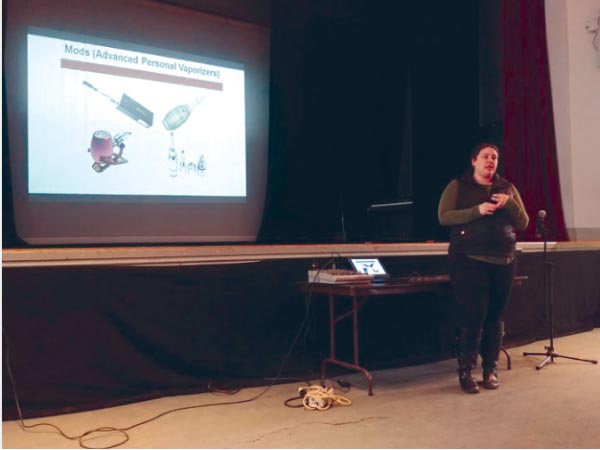Middle School Students, Staff Learn About Dangers of Vaping

Learning the Lingo: Katelyn Bianco From the Cranston Substance Abuse Task Force Helped to Educate the Students at Each of the Middle Schools About the Dangers of Vaping and the Serious Effects of the Chemicals Contained in E-cigarette Pods.
By JEN COWART
As the vaping epidemic affects young people across the nation, the Cranston Substance Abuse Task Force, Cranston Public Schools and Cranston Police Department are working together to help take on the issue by educating students.
All of the eighth-grade students in Cranston Public Schools, along with their physical education and health teachers, have been presented with a vaping presentation by Dana DeVerna and Katelyn Bianco from the Cranston Substance Abuse Task Force. The school resource officers from the middle school level were present at the assemblies.
“This is new to a lot of people. It’s new even to us and to your teachers,” Officer Kevin Denneny said during the Hugh B. Bain event earlier in March. “There aren’t any stupid questions here today.”
The students were asked a series of questions, just to get an idea of their general exposure to vaping as middle schoolers. They were asked if they or any of their peers vape, and if they knew anyone who had vaped inside the school. Hands were raised in answer to each question.
Bianco presented the students with e-cigarette basics, going over the health risks of vaping, the details about what dangerous chemicals are contained in e-cigarettes and the background about the marketing of e-cigarettes to the teenage generation, especially the Juul brand. She also detailed the history of e-cigarette production.
“With every pod, there is nicotine,” she said. “You’re never getting one without it. Each pod contains about 5 percent nicotine.”
She equated the use of vaping devices to cigarette smoking.
“One pack of cigarettes contains 20 cigarettes. One Juul pod is the equivalent of 20 cigarettes, and if you have a bigger pod, you are getting two packs’ worth of cigarettes in one pod, and the nicotine in e-cigarettes is not filtered as it is in regular cigarettes,” she said.
Denneny asked the students how many of them were involved in sports or were physically active in some way. Many in the audience raised their hands.
“How many of you would take a whole pack of cigarettes and smoke it before a game or before a jog?” he asked. “There are students now who are doing that by vaping.”
The students learned that vaping leads to a nicotine high, which causes an increase in heart rate, trouble breathing, damage to lungs and acid reflux. Long-term effects included coughing, irritation of the lungs, nose and throat, and dry, cracked skin.
Bianco emphasized that because vaping is relatively new, the research on true effects and long-term issues is limited. New information is learned along the way as more effects are seen with long-term use.
“The one thing we do know for sure in terms of long-term effects is that those who vape long term develop popcorn lung,” she said. “Popcorn lung was first seen in popcorn plant workers who developed it from the chemicals in the butter flavor of popcorn. Popcorn lung is irreversible. Once you get it, there is no treatment to reverse it. Earlier diagnosis is better, but the longer you’re vaping … the worse it is. The only way to prevent popcorn lung is not to do it – no Juuling, no vaping.”
The students were asked how many of them had heard the myth that the vapor produced by e-cigarettes is only water vapor. Many hands went up in the audience.
“That is not true,” she said. “They were marketed that way, but they contain an aerosol which can still be felt later. It leaves an aftermath and it leads to third-hand smoke.”
She said the vapors come into contact with items, such as a bowl of fruit in a kitchen, where someone is vaping. Anyone who later eats a piece of fruit from the bowl will be consuming the same chemicals as those who were vaping.
Denneny implored the students to remember that fact and to be cautious with younger siblings and those around them.
The students were told that the chemicals in e-cigarettes include substances listed on the U.S. Food and Drug Administration’s harmful substances list. Those same chemicals are contained in items familiar to the students, such as antifreeze, nail polish remover, paint, pesticides, embalming fluid, cigarettes and fireworks.
“Ladies, how many of you would open up the bottle and take a big sip out of your nail polish remover?” Denneny asked. “That sounds so crazy, but that is what kids are doing when they’re vaping. This stuff is no joke and it’s really bad for you guys.”
He said students should be angry that the e-cigarettes are being marketed to young people.
“They are targeting you because they want you to be hooked for life,” he said. “It’s just like a drug dealer dealing you drugs on the side of the road. They are looking to replace this current generation of smokers who are dying off. They know that if they get you now, they have you for life.”
“This is not just a Cranston issue,” DeVerna added. “This is happening all across Rhode Island and nationwide.”
